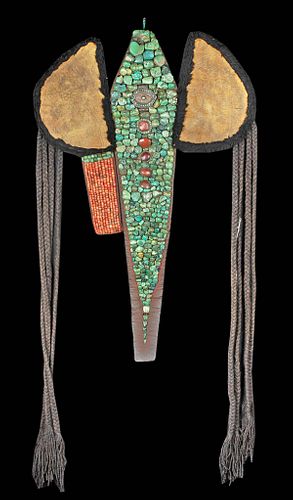20th C. Indian Tibetan Perak Headdress Turquoise, Coral
Lot 93
About Seller
Artemis Fine Arts
686 S Taylor Ave, Ste 106
Louisville, CO 80027
United States
Selling antiquities, ancient and ethnographic art online since 1993, Artemis Gallery specializes in Classical Antiquities (Egyptian, Greek, Roman, Near Eastern), Asian, Pre-Columbian, African / Tribal / Oceanographic art. Our extensive inventory includes pottery, stone, metal, wood, glass and textil...Read more
Categories
Estimate:
$6,000 - $8,500
Absentee vs Live bid
Two ways to bid:
- Leave a max absentee bid and the platform will bid on your behalf up to your maximum bid during the live auction.
- Bid live during the auction and your bids will be submitted real-time to the auctioneer.
Bid Increments
| Price | Bid Increment |
|---|---|
| $0 | $25 |
| $300 | $50 |
| $1,000 | $100 |
| $2,000 | $250 |
| $5,000 | $500 |
| $10,000 | $1,000 |
| $20,000 | $2,500 |
| $50,000 | $5,000 |
| $100,000 | $10,000 |
| $200,000 | $20,000 |
About Auction
By Artemis Fine Arts
Mar 24, 2022
Set Reminder
2022-03-24 10:00:00
2022-03-24 10:00:00
America/New_York
Bidsquare
Bidsquare : Exceptional Antiquities Ethnographic Fine Art
https://www.bidsquare.com/auctions/artemis-gallery/exceptional-antiquities-ethnographic-fine-art-9057
Museum-worthy examples of classical antiquities (Egyptian, Greek, Roman, Near Eastern), Viking, Far East / Asian, Pre-Columbian, African / Tribal, Oceanic, Native American, Spanish Colonial, Fossils, Ancient Jewelry, Fine / Visual Arts, so much more! Artemis Fine Arts info@artemisgallery.com
Museum-worthy examples of classical antiquities (Egyptian, Greek, Roman, Near Eastern), Viking, Far East / Asian, Pre-Columbian, African / Tribal, Oceanic, Native American, Spanish Colonial, Fossils, Ancient Jewelry, Fine / Visual Arts, so much more! Artemis Fine Arts info@artemisgallery.com
- Lot Description
South Asia or Central Asia, Northern India or Tibet, Ladakh region, ca. early to mid-20th century CE. This is a rare and stunning headdress known as a perak or perag, worn by the women of the Himalayan foothills region of Tibet and Northern India, made of cotton cloth panels covered in dozens of turquoise, carnelian, coral beads, and a silver pendant. Each turquoise and carnelian are drilled or pierced and sewn onto a padded triangular cloth which is the main panel for the perak - the wide front rests on the brow, and the narrow end drapes down the neck. At the center are 5 large carnelian stones and a gahu pendant of a high quality 71% silver and 23% gold alloy inlaid with turquoise stones, and a secondary side panel is adorned with dozens of coral beads. The broad ear flaps of beige cloth are trimmed in black lamb's fleece to protect against the wind and cold, and the long-braided cords are made of yak hair to tie behind the wearer's back. Size: 31" L x 20" W (78.7 cm x 50.8 cm); pendant metal content: 71% silver and 23% gold
These perak headdresses are quite heavy and opulent displays of social status which literally stored a woman's wealth. The valuable stones and jewelry attached were her own, and not part of her husband's property - she had the power to barter with the stones and jewelry as needed to provide for her family. The rows of turquoise also indicated status - traditionally 9 rows for the queen, 7 for elite women, and 5 then 3 for minor citizens. Mothers would usually present their perak to the oldest daughter upon her marriage and begin the process of collecting and making another for herself. These peraks that passed through many generations are often the most laden with precious stones and the largest most precious turquoise nuggets are often placed at the top. The ear flaps provide warmth, but the shape is also symbolic of a cobra hood to represent protection as do the stones themselves. Traditionally these peraks were worn in daily life and only taken off to sleep.
For a similar example and more information about peraks, please see the Bowers Museum website article "Snakes and Stones: Perak Headdresses from Ladakh."
Provenance: Whisnant Gallery, New Orleans, Louisiana, USA acquired prior to 2000
All items legal to buy/sell under U.S. Statute covering cultural patrimony Code 2600, CHAPTER 14, and are guaranteed to be as described or your money back.
A Certificate of Authenticity will accompany all winning bids.
PLEASE NOTE: Due to recent increases of shipments being seized by Australian & German customs (even for items with pre-UNESCO provenance), we will no longer ship most antiquities and ancient Chinese art to Australia & Germany. For categories of items that are acceptable to ship to Australia or Germany, please contact us directly or work with your local customs brokerage firm.
Display stands not described as included/custom in the item description are for photography purposes only and will not be included with the item upon shipping.
#169798Cotton panel is stained and discolored as expected with heavy use. Threads on the coral panel and ear flaps that attach to main panel are unraveling and loosening, these 3 panels need to be handled with care, and can easily be reinforced. Staining to ear flap cloth, but intact and very good. Stones and jewelry throughout are tightly sewn and secure. Some nicks, chips, and abrasions to stones and jewelry. Yak cords are tightly braided and intact.Condition
- Shipping Info
-
All shipping is handled in-house for your convenience. Your invoice from Artemis Gallery will include shipping calculation instructions. If in doubt, please inquire BEFORE bidding for estimated shipping costs for individual items.
-
- Buyer's Premium



 EUR
EUR CAD
CAD AUD
AUD GBP
GBP MXN
MXN HKD
HKD CNY
CNY MYR
MYR SEK
SEK SGD
SGD CHF
CHF THB
THB













